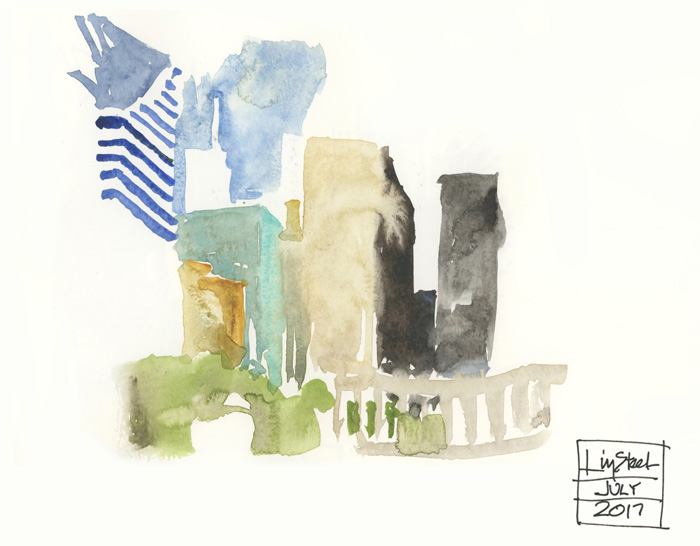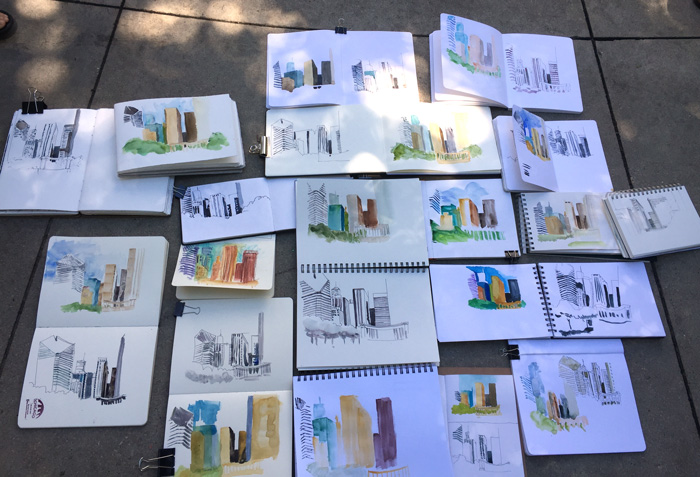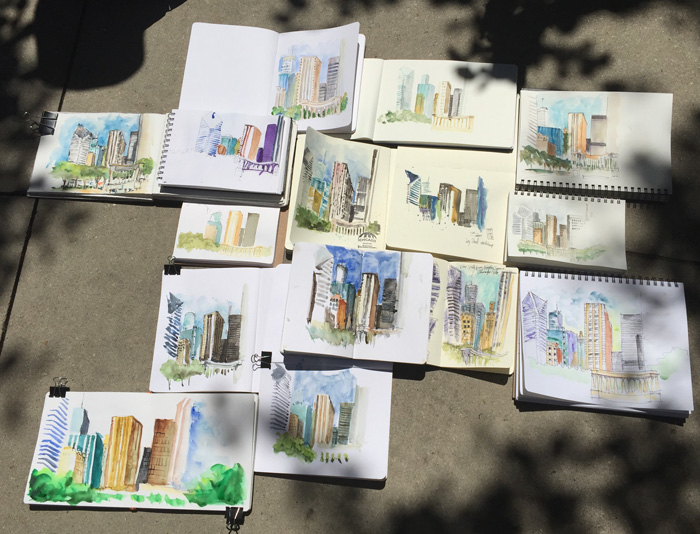
I love sketching complicated architecture quickly and loosely but drawing buildings with a lot of repetition is rather challenging to do with my style. The buildings of Chicago (especially the early/Art Deco skycrapers) fit this catergory but I’m pleased that after 2 weeks working at it, I now have a system for sketching them with a good rhythm and flow.

So this means that this year at the Urban Sketchers Symposium I was teaching techniques that were newly developed and implemented, making it fresh and particularly rewarding. I also loved my workshop location – Wrigley Square in the top northern corner of Millennium Park – and the small collection of buildings that we focused in on for the exercises. Indeed the star of the show was the amazing changing light on the facade of a Mies Van Der Rohe building – the black building.

I was realy pleased that I had a 1.5 week’s worth of sketching the city to share with my workshop participants, showing first hand how I had implemented the concepts we explored together.
My workshop had three parts:
1. Exploring Structure

The first exercise involved drawing the basic volumes of the buildings in front of us – drawing ‘ink only’, starting with the biggest boxes, and then looking for angles, relationships, negative shapes.
We then looked for the dominant pattern of each building’s structure (vertical or horizontal) and being careful with the scale of the patterns. Drawing volumes first and structure second (not windows or details) is a major part of the way I sketch architecture (explained in full in my SketchingNow Buildings course).

One of the biggest challenges in drawing the buildings of Chicago was scaling down what we saw to fit on our page. As the buildings were so huge and so close to us, the windows looked big but when we tried to fit them on the page they were reduced to a single line. Drawing the windows the size we felt them to be typcially resulted in a 50% inaccuracy in the number of the storeys – ie. it was easy to find that we had only drawn 5 storeys when in fact there was 10!

I shared my technique for getting a better accuracy by quickly counting the storeys in blocks of 5 and then transfering that to the page. Every time I did this I was shocked by how small on the page each storey was. Here is the sheet from my teaching folder about that.
I also them shared how looking for the structural pattern (rather than the windows) was the secret to being able to fade the details.
2. Exploring Shape

We then switched modes of visual thinking and did a quick ‘Abstracting Shapes’ exercise (from SketchingNow Foundations) drawing in paint and just focusing on the big colour shapes. Most people find this a fun exercise even though it is a little hard to go straight to paint when you are not used to it. In this case I made it a little easier by sticking to the same composition as the previous line exercise.

And then we drew another quick outline of the volumes and only painted the ‘dark’ areas. Normally when I set this exercise the goal is to ‘map’ the shaded areas only, but in Chicago with all the glass buildings and reflections it was often impossible to work out what was what. So instead, we simply squinted and painted (in dark grey) any areas which were dark.
The really fun part was that the dark areas were a combination of local colour, cast shadow on solid elements, reflections on glass.

This is where the Mies building did some amazing things for us and was constantly changing – I had a few major geek-out moments watching the lighting condition change and reveal different aspects of the architecture! But hey, isn’t excitement about the effects of light a major part of being an artist?

I really wanted people to start thinking about lights and darks irrespective of what part of the building it was. (This was so totally different from the first exercise). And I also wanted them to realise that starting with darks in your sketches is a super powerful technique. Not only does it make your sketching fast and looser, but it is also the way you achieve lost and found edges – overexposing the highlights and underexposing the darks. (I explain this in much more detail in SketchingNow Edges)
3. Putting it Together

The final part of the workshop was a chance for people to put these concepts together by working with line and colour.

I encouraged people to try painting the darks first and then drawing over the top.

Here are photos of the three wonderful groups… it was so much fun and an honour to teach you – thankyou!

Also a special thank you to the Friday group who worked hard despite the nearby jazz band and my trying to shout over the top.

(Note: If you want a copy of the group photo please email me using the contact form above)
Thank you all for choosing my workshop (there were so many other amazing ones to choose from) and I really hope that you were able to take away a few techniques that you can incorporate into your work. I loved every minute of it and it was very satisfying to be able to teach a few more advanced techniques than I normally teach (in face to face workshops and online courses).
Finally: here is the handout!
Download PDF Handout: LizSteel Lost and Found Structure








7 Comments
Wonderful ! I feel like I was there (and wished that I could have been ) > Love the concepts and the examples, Your students were so fortunate to shared in this experience and your knowledge
Can’t get the PDF to load or download
Chris, not sure why that is happening – other people seem to be able to. I will email it to you.
We had tons of fun and I learned a lot!! Also, you signed my book and I feel very glad. Hope to see you soon
Liz thanks for sharing another great blog with information and some of your wonderful sketches. It looks like it was a great trip with lots of special people to share the event with. And lots of beautiful buildings to sketch. I live in Illinois a few hours south of Chicago, maybe someday I will get to do some sketching there. I have a lot to learn before I do that though and you are an inspiration for me to do more and improve what skills I have. Thanks again.
Liz, thanks for sharing your steps again. You explained it all here so clearly. It was such a pleasure to be in your workshop in Chicago. I see myself in the third group photo down on the bottom left. The next time I head into NYC with our group I will have to see if I can use your ideas for sketching these tall buildings. Thanks!!!
Looks like it was a great workshop. I share your love of Mies Van Der Rohe buildings. A pity so many have been built around with bigger buildings!
NEWSLETTER
Subscribe for first notification of workshop + online classes and more.